Frequently Asked Questions About Giving Feedback
Tips. Models. Frameworks. Research.
Giving feedback is perhaps the most powerful tool we have to foster growth, build trust, and create lasting impact—at work, in school, and in life. But for something so essential, few of us are ever taught how to do it well. This guide answers the most common and emerging questions about giving feedback, based on real-world experience, research, and modern workplace realities.
Foundations of Giving Feedback
What is giving feedback?
Giving feedback is the process of providing someone with insights—both affirming and developmental—about their behavior, work, or performance. At its best, it’s not a monologue but a dialogue: feedback is offered not to judge, but to help the other person grow, improve, or reflect. Effective feedback is specific, timely, and grounded in observable behavior, not assumptions or personal attacks.
Why is giving feedback important in the workplace?
Giving feedback in the workplace helps people understand how their actions impact others, reinforces what’s working, and identifies opportunities to grow. Teams that give feedback well adapt faster, innovate more often, and build deeper trust. Feedback is also essential to creating cultures of accountability—without it, resentment and confusion fester quietly.
What are the key principles of effective feedback?
The core principles include:
- Clarity: Be specific about the behavior, not vague.
- Respect: Center the relationship and speak with care.
- Timeliness: The closer to the behavior, the more useful (not always, but usually).
- Balance: Offer both affirming and developmental feedback over time.
- Dialogue: Invite the receiver in—most feedback should feel like a conversation, not a command.
For more on this topic, see: Giving Feedback as Directive vs. Guide.
What makes feedback constructive vs. critical?
Constructive feedback is meant to help. It’s behavior-focused, actionable, and grounded in care. Critical feedback, when unskillfully delivered, often focuses on the person instead of the behavior, and can leave the receiver feeling judged or shamed. Constructive feedback might sound like: “Here’s what I observed, and here’s what could help,” rather than “You did this wrong. Why would you do such a thing?”
How is feedback different from criticism or praise?
Feedback can be both criticism and praise, but it’s about learning. Praise often celebrates outcomes (which can help someone double-down on their strengths), and criticism tends to focus on faults (which can help someone see their gaps). Feedback, done well, connects observed behavior with impact and improvement. It supports reflection and growth. Think of feedback as information with purpose.
What are common misconceptions about giving feedback?
Some of the biggest myths include:
- “Feedback has to be negative.”
- “If no one’s complaining, everything’s fine.”
- “Good work speaks for itself—no need to say anything.”
- “You can’t give feedback unless you’re the boss.”
These beliefs lead to silence, misalignment, and missed opportunities for growth. For more on this topic, see the video titled 5 Feedback Myths: Debunking with an Evidence-Based Approach:
What are the risks of not giving feedback?
Silence has a cost. When we avoid giving feedback:
- Small issues can become bigger ones.
- People miss out on learning they crave.
- At work, retention issues arise.
- Trust erodes—people notice when leaders don’t speak up.
- Innovation stalls because ideas aren’t pressure-tested.
Not giving feedback is rarely neutral; it often signals fear or disengagement.
What are the qualities of an effective feedback giver?
Strong feedback givers are:
- Observant: They notice behaviors, not just outcomes.
- Curious: They aim to understand, not assume.
- Empathetic: They consider how their message will land.
- Courageous: They’re willing to have uncomfortable conversations.
- Clear: They speak with intention, not ambiguity.
How can feedback foster a culture of growth?
When feedback is given regularly and respectfully, it signals that learning is safe, expected, and valued. It normalizes asking questions, trying new approaches, and talking about what’s working and what isn’t. Over time, feedback-rich cultures become more resilient, more innovative, more willing to speak up on ethical issues, and better able to navigate change.
What mindset should I have when giving feedback?
Go in with the mindset of a coach, not a critic. Your goal is to help—not to win, prove, or shame. Assume the person wants to grow. Be open to hearing their perspective, too. And remember: good feedback is as much about how you say it as what you say.
For more on this topic, read: The Feedback Giver’s Mindset
Giving Feedback at Work
How do I give feedback at work without sounding rude?
Start with your intention—make it clear that your goal is to help, not to criticize. Then focus on observable behavior, not personality or assumptions. For example, instead of “You’re unprepared,” try: “In today’s meeting, you didn’t reference the numbers we agreed to include, which made it harder to align on next steps.” When in doubt, ask for permission: “Would it be okay if I shared an observation that might help next time?”
For more on the power of intention, see the following articles:
What are examples of giving feedback professionally?
- Positive: “Your weekly updates have been really clear and concise. They’re helping the team stay aligned.”
- Developmental: “During your presentation yesterday, I noticed several questions went unanswered. I think taking a few moments to prepare potential Q&A in advance could boost your confidence and impact.”
Both examples are professional because they’re specific, respectful, and focused on improvement or appreciation—not on judgment.
How do I give feedback to someone older or more experienced?
Start with respect. Acknowledge their experience and frame your feedback as a contribution, not a correction. You might say: “I really respect how you handled that client question. I noticed one small thing that might help next time—would it be okay if I shared it?” Many experienced professionals appreciate feedback when it’s delivered with thoughtfulness and clarity. Your goal is to support, not undermine, their expertise.
For more on the topic of age, read: Feedback and Age: Research Insight
How often should I give feedback at work?
Often enough that it doesn’t feel like a surprise. Waiting for performance reviews to give feedback makes it feel high-stakes and disconnected. Instead, aim for short, in-the-moment conversations whenever you see something worth reinforcing or improving. When feedback is consistent and well-timed, it becomes part of team culture—not an event to brace for.
What is the best way to prepare for a feedback conversation?
- Get clear on your intent—Why are you sharing this? What outcome do you hope for?
- Gather your observations—What did you see or hear, specifically?
- Practice empathy—How might the other person feel or interpret this?
- Choose the right time and setting—Privacy, tone, and timing matter.
- Invite dialogue—Feedback isn’t a monologue; be ready to listen.
A little preparation can turn a tense moment into a meaningful one.
How long should a feedback conversation take?
Many feedback moments take just a few minutes. A quick but specific, well-timed comment (“Thanks for helping in that meeting. Your summary kept us on track”) can go a long way. Longer conversations (10–30 minutes) are better for more complex topics, like patterns of behavior or career development. Let the feedback guide the length, not the other way around.
What’s the best way to follow up after giving feedback?
Follow-up shows care and helps reinforce learning. You might check in a few days later to ask, “How did you feel about that conversation?” or “Have you had a chance to try that approach yet?” It doesn’t need to be formal—just a simple, supportive gesture to show that the conversation mattered and you’re still invested.
For more on this topic, read: Why Checking In After Giving Feedback is So Powerful
How do I give feedback when I don’t supervise the person?
Feedback doesn’t have to flow only down. When you’re not someone’s manager, frame your feedback as an observation and an offer, not a directive. Try: “I noticed something that might be useful—can I share it?” Grounding your message in shared goals or team impact (“I think it might help us work more smoothly together…”) can help remove friction and open up conversation.
How can I give feedback in a performance review?
Performance reviews should never be the first time someone hears important feedback. That said, they’re an opportunity to synthesize observations, celebrate progress, and set direction. Be sure to balance reinforcing what’s working with developmental insights. Structure helps—models like SBI or STAR can help you organize your thoughts. And always invite reflection: “What’s something you’re proud of this cycle?” “What support would help you stretch next quarter?”
What should I do if my feedback isn’t received well?
Not all feedback lands cleanly, and that’s okay. Stay calm and curious. You might say: “It seems like this was tough to hear—can we talk about what came up for you?” Give space, and don’t push for agreement. Remember: your job isn’t to control the reaction, but to create a respectful space for reflection. Sometimes the value of feedback emerges days or weeks later.
Giving Feedback Across Relationships
How do I give feedback to my manager?
Giving feedback upward requires tact and timing. Start by asking for permission: “Would it be okay if I shared a quick reflection that might help?” Keep your tone collaborative, not corrective. Anchor your feedback in shared goals (“I think this could improve team communication”) and be specific about what you observed. Avoid venting—this is about professional growth, not personal frustration.
How do I give feedback to a peer or coworker?
Peer feedback works best when grounded in support. Frame it as something you’re offering, not imposing: “I noticed something that might be helpful—can I share it?” Use a moment when you’re both calm and not rushed. When possible, focus on collaboration and impact.
For more on this topic, read: How to Leverage Peer-to-Peer Feedback
How do I give feedback to a direct report?
Feedback to direct reports should nearly always feel developmental, not disciplinary. Be specific about the behavior, share the impact, and ask open-ended questions that invite dialogue. Avoid feedback as a “gotcha” moment—make it a tool for learning.
How can I give feedback to someone in a different department?
When giving feedback across departments, context and intent matter. Clarify why you’re sharing the feedback and how it relates to shared goals. For example: “I noticed something during our handoff that might affect timelines—would it help to talk it through?” Cross-functional feedback often lands better when it’s framed as a collaboration opportunity rather than a correction.
How do I give feedback without hurting the relationship?
Feedback doesn’t have to damage relationships—when done well, it deepens them. The key is intent and tone. Express care up front (“I’m sharing this because I want us to succeed”), be specific without blame, and invite the other person’s perspective. Feedback that’s curious and respectful builds psychological safety. The real risk usually isn’t caring feedback—it’s silence.
How can I give feedback to someone I don’t know well?
When you don’t have an established relationship, lean into curiosity and invitation. You might say: “I’m not sure how this will land, but I noticed something that could be helpful—can I share it?” Stay humble, avoid assuming too much, and offer feedback as an observation rather than a conclusion.
For more on this topic, read: Giving Feedback to New Teammates
How do I navigate feedback when power dynamics are involved?
Power differences shape how feedback is given and received. If you’re in a position of authority, remember that your words carry extra weight—feedback can feel like a judgment even when it’s meant as support. If you’re offering feedback to someone with more power, frame it through mutual goals and curiosity.
To go deeper on this topic, read: Giving Downward Feedback? Ease the Power Dynamic.
Can I give feedback in personal relationships using the same frameworks?
Yes—but adjust for emotion and intimacy. The core principles still apply: be specific, speak with care, and invite dialogue. But in personal relationships, timing and tone matter even more. You might say: “Can we talk about something that’s been on my mind?” In these contexts, frameworks like SBI can help, but the real key is connection.
How do I set boundaries when giving feedback to friends or family?
Not every moment is a feedback moment. In personal relationships, be mindful of emotional capacity—yours and theirs. Ask yourself: “Is this feedback for them, or is it to relieve something in me?” If you choose to share, state your boundaries clearly: “I want to talk about something, and I’m sharing it because I care—but I also want to make sure we’re okay after.” Sometimes the best boundary is choosing not to give feedback right now.
Giving Feedback Virtually and Across Cultures
How do I give feedback in a remote or hybrid work environment?
In remote and hybrid environments, feedback needs to be more intentional. Clarify your intent early and be concise. Whenever possible, use live video or voice for nuance, and follow up in writing for clarity. Remote feedback isn’t harder—it can just require more structure and care.
What are best practices for giving feedback via video or chat?
When using video, keep your tone warm and your message focused. Don’t multitask or rush. When using chat, avoid ambiguity. Written feedback can feel colder than intended, so use clear, respectful language and offer to discuss it live if needed. Consider using phrases like, “I’m sharing this to support, not criticize—let me know if you want to chat it through.”
Should I give feedback over email?
Email is best for routine, positive, or low-stakes feedback—especially when paired with clarity and context. But avoid email for emotionally charged or complex feedback. If written feedback is necessary, use a clear structure like SBI or EEC, and state your intent up front.
How do I give feedback across cultures respectfully?
The key is cultural humility. What feels clear in one culture may feel blunt or inappropriate in another. Avoid one-size-fits-all approaches. Learn how direct or indirect the other culture tends to be, and adapt your delivery accordingly. When unsure, ask: “How do you prefer to receive feedback?”
What cultural differences affect how feedback is received?
In high-context cultures (e.g., Japan, Nigeria), feedback may be more indirect and layered with subtle cues. In low-context cultures (e.g., Germany, U.S.), directness may be more expected and valued. Some cultures expect feedback only from senior leaders, while others value peer-to-peer input. Knowing these dynamics helps ensure your message is understood.
What are tips for giving feedback across language barriers?
Use plain, simple language. Avoid idioms or jargon. Break ideas into short, clear sentences. Ask questions to check understanding—“Does that make sense?”—and be patient. When possible, share follow-up notes in writing.
What should I avoid when giving feedback to someone from a different cultural background?
Avoid assuming your communication style is universal. Be cautious with humor, metaphors, or overly casual phrasing. Avoid public feedback unless you know it’s culturally appropriate. Most of all, don’t skip feedback out of fear—silence can be harmful.
Feedback Frameworks and Models
What is the SBI™ Feedback Model?

The SBI™ (Situation–Behavior–Impact) Feedback Model helps feedback givers stay specific, objective, and focused on the observable behavior. The model has three parts:
- Situation: Identify when and where the behavior occurred.
- Behavior: Describe the behavior you directly observed.
- Impact: Share how that behavior affected you or others.
How does the SBII (SBI + Intent) model work?
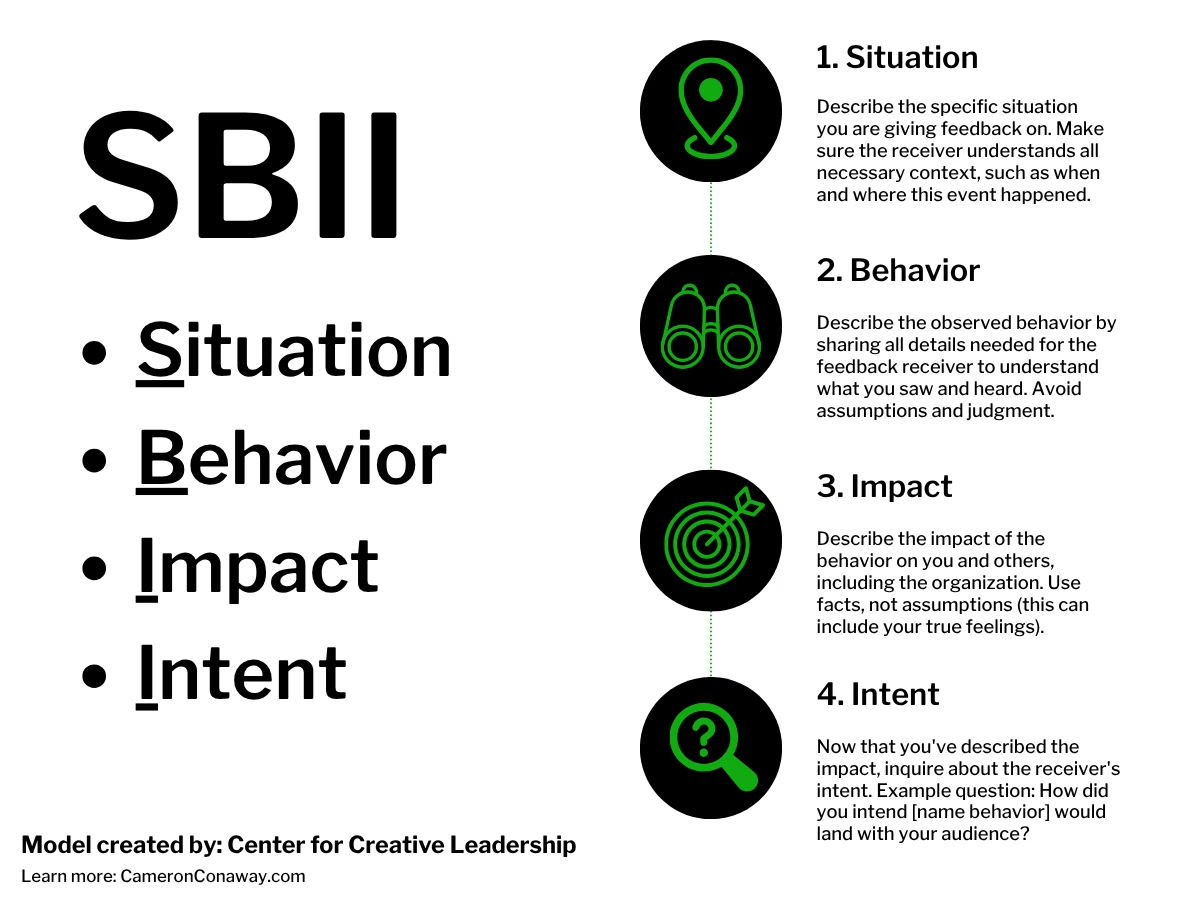
SBII adds a critical fourth step to the SBI™ model: Intent. It encourages feedback givers to clarify not only what happened and why it mattered—but also what they believe the person intended. This reduces misunderstandings and invites curiosity rather than blame.
What is the R-SBI-R model and how is it different from SBI™?
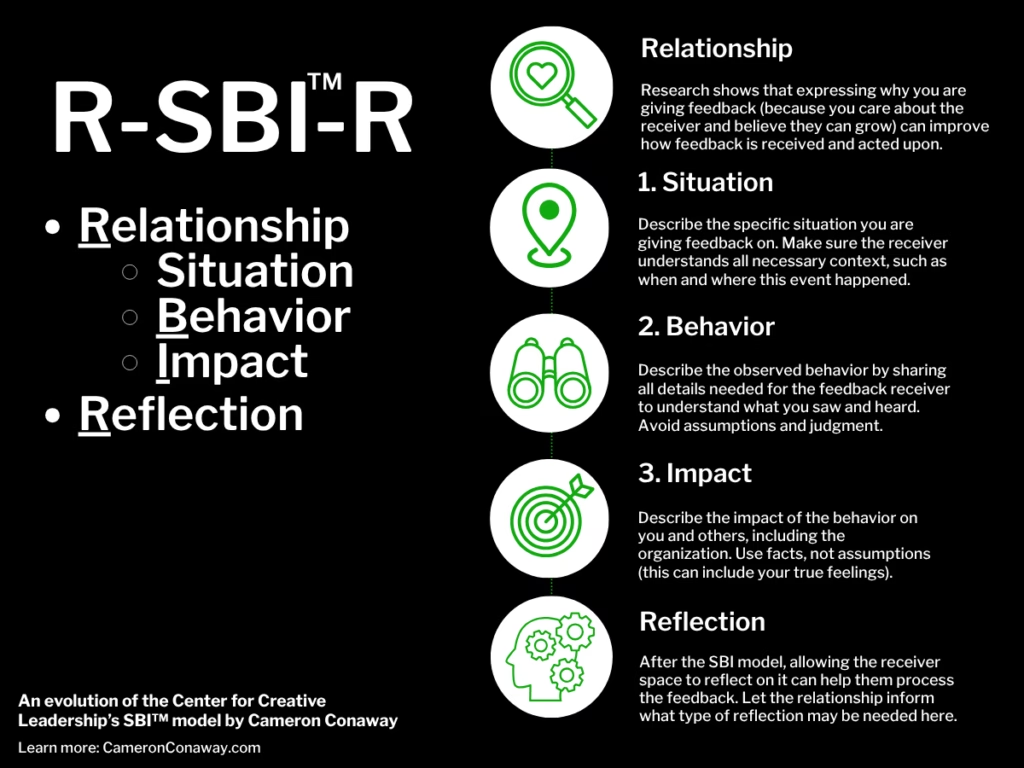
The R-SBI-R model (Relationship–Situation–Behavior–Impact–Reflection) was developed by Cameron Conaway as an evolution of the original SBI™. It adds two essential bookends:
- Relationship: Begin by affirming the relationship or why you care.
- Reflection: End by creating space for the receiver to process and respond.
This version is especially helpful when feedback is emotionally charged.
What is the STAR feedback model?
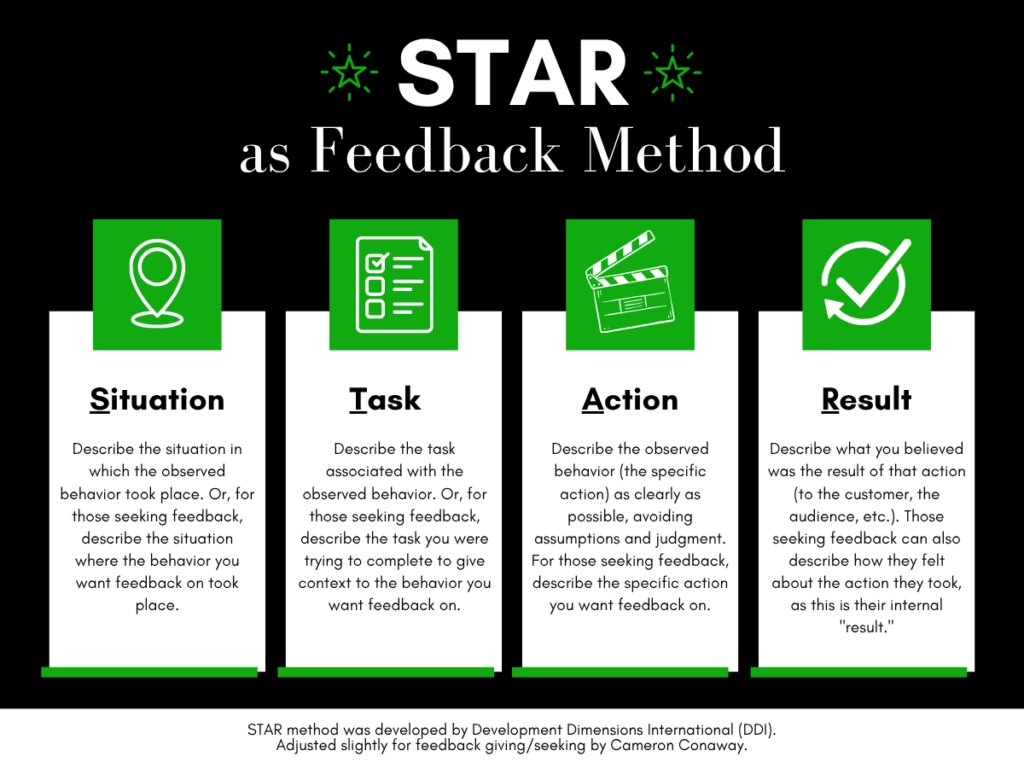
STAR stands for Situation, Task, Action, Result. Originally developed for behavioral interviewing, it’s also a strong framework for giving and receiving feedback—especially when tied to performance outcomes.
What is the Pendleton Model?
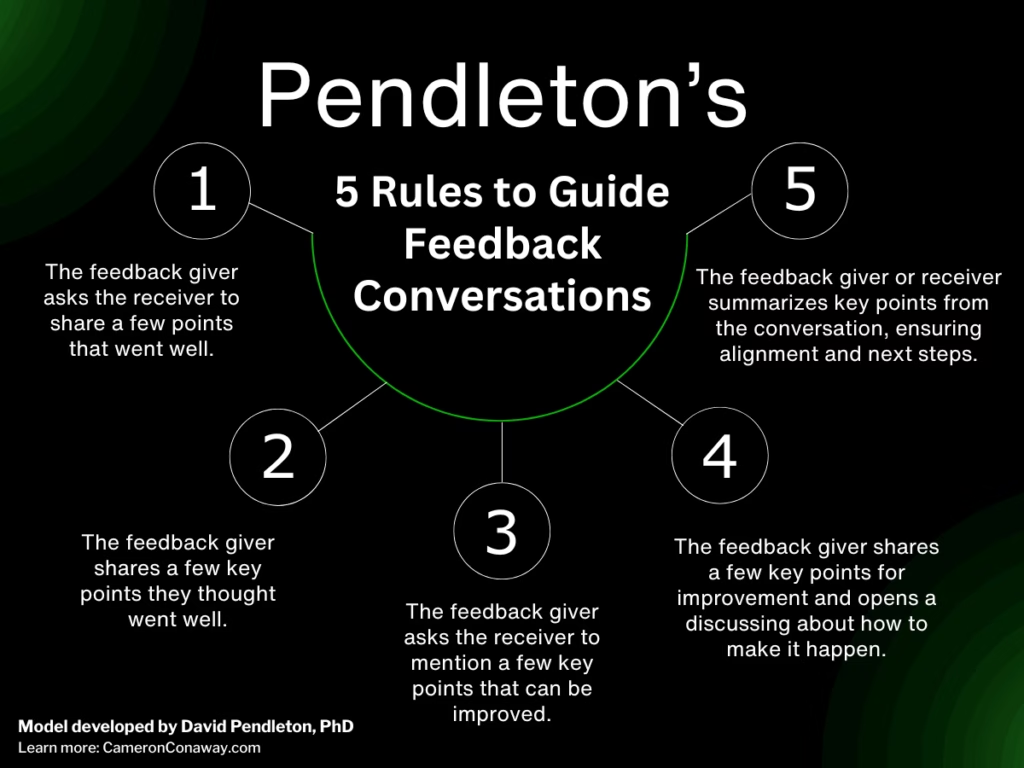
The Pendleton Model is a five-step conversation framework used widely in medical education. It encourages structured two-way feedback with emphasis on both strengths and areas for growth. The five steps are:
- Ask the receiver what went well.
- Share what you thought went well.
- Ask what could be improved.
- Share your suggestions for improvement.
- Summarize and align on next steps.
How does the EEC model work?
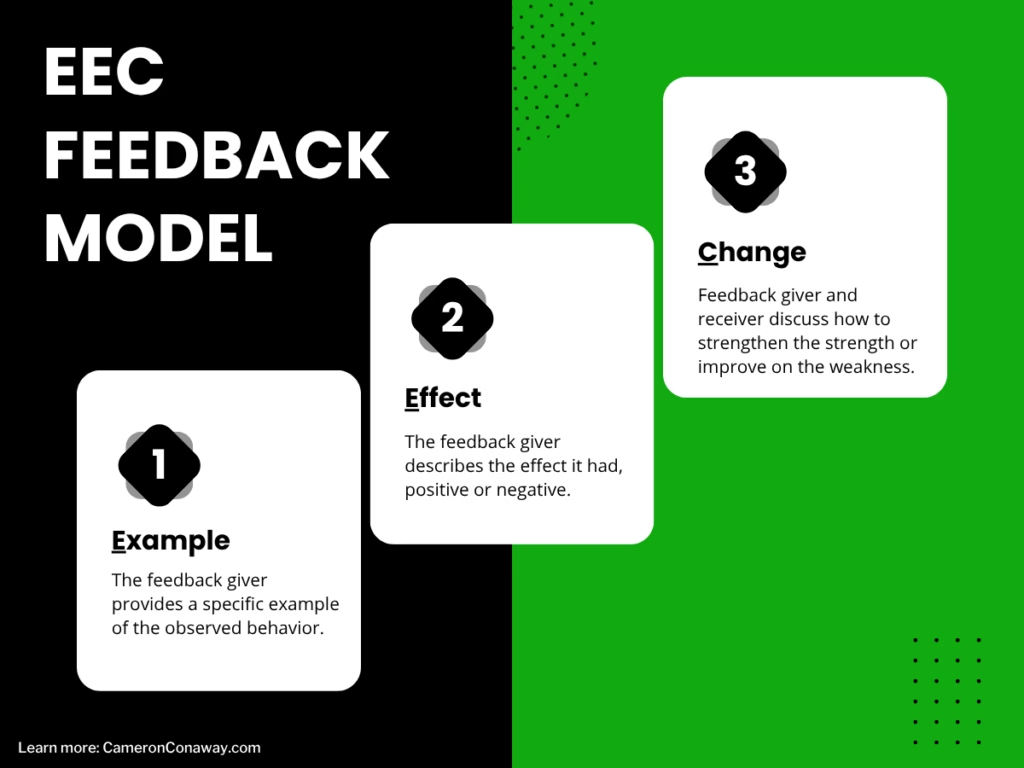
The EEC model stands for Example, Effect, Change. It’s a simple and practical way to provide developmental feedback in real time.
What is the DESC framework for giving feedback?
DESC stands for Describe, Express, Specify, Consequences. It’s a communication tool designed to help people assertively express concerns without escalating conflict—often used in healthcare and high-stakes workplace settings.
How do you use the IDEA model?
The IDEA model is a coaching-oriented framework that stands for:
- Identify the behavior.
- Describe the impact.
- Explore alternatives.
- Agree on next steps.
What is the CEDAR model?
The CEDAR model is a five-step structure used to guide performance feedback, often in formal 1:1 settings. It stands for: Context, Examples, Diagnosis, Action, Review.
What is the BOOST feedback model?
BOOST stands for Balanced, Observed, Objective, Specific, Timely. It’s useful for ensuring that feedback meets basic quality standards and is often used in academic and military settings.
What is the Feedback Sandwich method and should I use it?
The Feedback Sandwich involves delivering criticism between two pieces of praise. While widely used, it’s also widely criticized (including by me here). Receivers may focus only on the praise and miss the point—or see the structure as manipulative.
What is 360-degree feedback?
360-degree feedback is a system enabling employees to receive feedback from various sources, including managers, peers, direct reports, and sometimes customers. Used effectively, it helps reduce bias and surface blind spots.
What is McKinsey’s Action-Feeling-Feedback model?
This model helps feedback givers connect specific behavior to its emotional and constructive impacts. It follows a simple three-part structure: Action (what they did), Feeling (how it made you feel), and Feedback (next steps). By naming the feeling, this model adds empathy to the feedback process.
What is the SAID model of feedback?
SAID stands for Situation–Action–Impact–Desired Outcome. It is similar to SBI™ but adds a final step to guide future behavior.
What is the Stanford Method of feedback?
The Stanford Method is often described as “I Like, I Wish, What If.” It is additive and respectful, encouraging creativity rather than forcing critique, making it ideal for design and innovation contexts.
What is the SKS (Start, Keep, Stop) framework?
The SKS model invites reflection by breaking feedback into three categories: Start (new behaviors), Keep (what works well), and Stop (what is ineffective). It is excellent for retrospectives.
What is the DISC model for feedback?
While DISC is primarily a behavioral assessment, it’s often applied to feedback by tailoring your approach to a person’s profile (Dominance, Influence, Steadiness, Conscientiousness) to reduce defensiveness.
What is the 4C model for giving better feedback?
The 4C Model stands for Clarity, Context, Compassion, Commitment. It is increasingly used in leadership development settings to balance accountability with empathy.
What is the FUEL feedback model?
The FUEL model guides feedback conversations through a four-step dialogue: Frame the conversation, Understand the current state, Explore the desired state, and Lay out a plan.
What is the RISE Model for meaningful feedback?
The RISE Model stands for Reflect, Inquire, Suggest, Elevate. Originally designed for peer review in education, it supports constructive, non-judgmental feedback.
What is the VARK framework?
VARK stands for Visual, Auditory, Reading/Writing, and Kinesthetic. It helps feedback givers tailor their approach to the recipient’s learning preference.
What is the LeeAnn Renninger 4-Part Feedback Formula?
Psychologist LeeAnn Renninger popularized a 4-part formula: 1. The Micro-Yes, 2. The Data Point, 3. The Impact Statement, 4. The Wrap-Up Question.
What is the COIN feedback model?
COIN stands for Context, Observation, Impact, Next Steps. It is widely used in corporate settings to deliver clear, balanced feedback.
What is the 3Ps model?
The 3Ps model (Praise, Problem, Potential) helps balance affirmation with growth. It is especially helpful for new managers.
What is the Employee Feedback Literacy Model?
Coined by Cameron Conaway, this research-based framework outlines five essential skills: Seek, Give, Receive, Process, and Use Feedback.
Handling Difficult Feedback Situations
How do I give feedback to someone who gets defensive?
Start by softening the entry: ask for permission. Use specific, neutral language and avoid exaggerations. If defensiveness arises, pause to check in: “It seems this struck a nerve—should we take a break?” Aim for a two-way dialogue, not a one-sided delivery.
How do I give feedback about sensitive issues?
Prepare carefully. Choose a private setting, anchor the conversation in care, and name the sensitivity upfront. Focus on behavior, not character. The goal isn’t just to give the feedback—it’s to preserve trust while doing so.
How do I handle feedback when emotions are high?
Slow down. It’s often better to delay a feedback conversation than to fumble through one where neither person can fully listen. When the moment is right, keep the feedback focused on observable actions. Remember: emotions aren’t the enemy—ignoring them is.
What do I do if I regret giving feedback?
Regret often signals reflection. If your feedback was harsh or misaligned, take responsibility. You might say, “I’ve been thinking about what I said yesterday, and I want to clarify or revisit that.” This models humility and invites trust.
How can I stay calm when giving difficult feedback?
Preparation is key. Rehearse what you want to say. During the talk, slow your speech and use pauses. If you feel yourself getting flustered, it’s okay to say, “Give me a second to gather my thoughts.” Calm means being steady enough to prioritize the relationship.
What if the feedback is about something I struggle with too?
Be honest and vulnerable: “This is something I’ve worked on too, and I still catch myself.” Framing the feedback as shared growth, not judgment, can reduce defensiveness and deepen the relationship.
How do I give feedback to someone resistant to change?
Meet resistance with curiosity. Ask questions to understand their hesitation. When people feel heard, they’re more likely to consider your input. Sometimes the key isn’t pressure—it’s patience.
How do I give feedback if I’ve been avoiding it for too long?
Start by owning the delay: “I’ve been meaning to bring something up and should’ve done so sooner.” Then get to the point gently but clearly. Procrastinated feedback often weighs on both parties. Giving it—even late—can rebuild clarity and trust.
Advanced Concepts and Trends
How do I give feedback using AI-generated insights?
Treat AI-generated feedback as a conversation starter, not a final judgment. Share the insight transparently and provide context. The key is to humanize the data: combine analytics with empathy.
How can giving feedback support diversity, equity, and inclusion?
Use inclusive language, stay alert to cultural differences, and make sure you’re giving all team members regular, high-quality feedback—not just the ones you naturally connect with. Ask for feedback on your feedback: “Did this land how I intended?”
How do generational differences affect how we give feedback?
While generations may have trends (e.g., Gen Z preferring real-time feedback), the best approach is personalization. Ask: “How do you prefer to receive feedback?” Tailoring your approach builds trust across generations.
What is the role of psychological safety when giving feedback?
Psychological safety is foundational. In environments where people fear embarrassment, feedback becomes rare. To foster safety, model vulnerability and reward people for speaking up.
How do I give feedback in a feedback-fatigued organization?
Cut through the noise by focusing on feedback that is timely, meaningful, and tied to real growth—not compliance. Be brief, specific, and curious.
How do high-performing teams give each other feedback?
High-performing teams normalize feedback as collaboration. They give it early and often, across hierarchies, and collectively build their employee feedback literacy.
How can I help others become better at giving feedback?
Model it. Narrate your approach. Create low-stakes opportunities for others to practice. When people see that giving feedback is a learnable skill, they’re more likely to grow in it.
Feedback is at the heart of growth.
Get Cameron’s free guide here. It includes the complete breakdown of feedback definitions, types, and examples in one easy-to-navigate PDF. Perfect for printing, sharing with your team, or keeping as a quick reference.
↓ Download the PDF